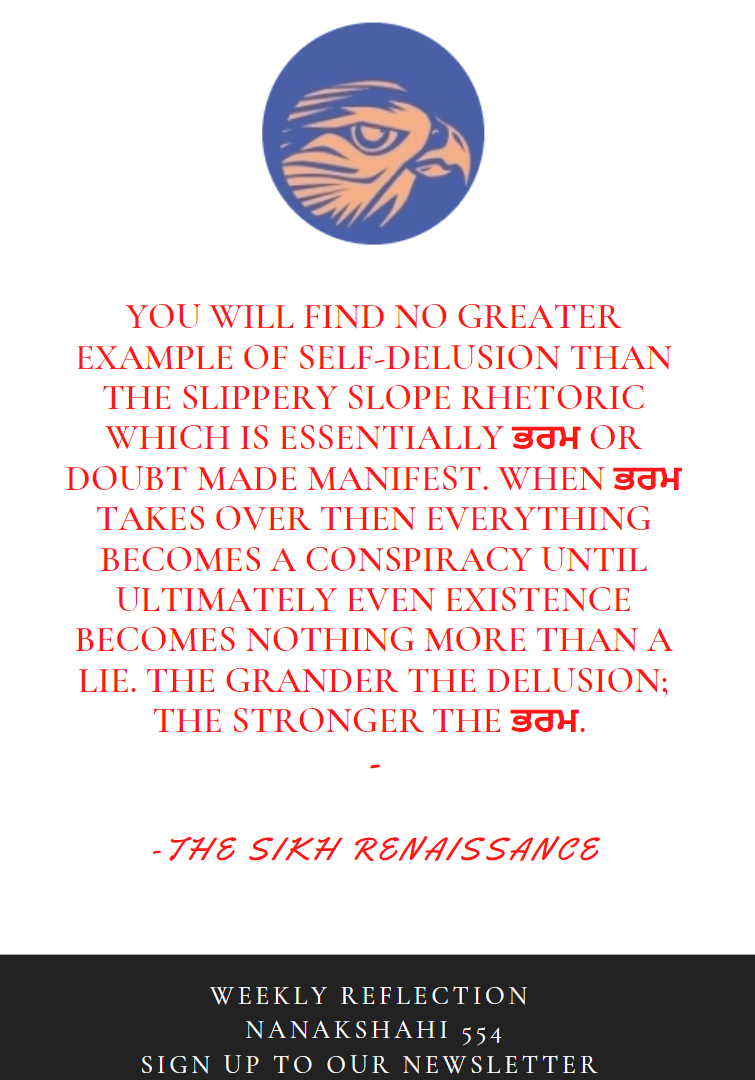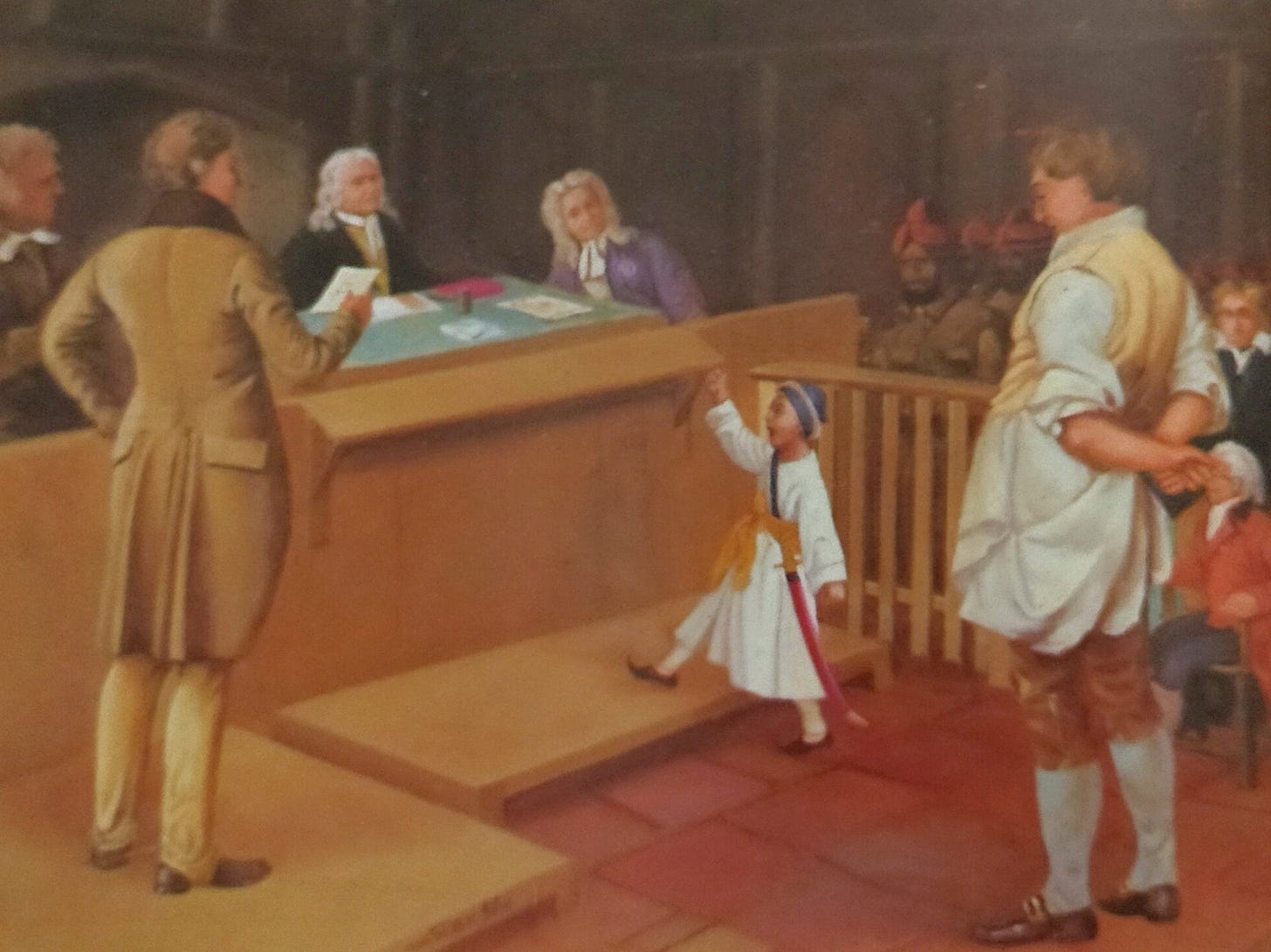Reflection:
‘You will find no greater example of self-delusion than the Slippery Slope rhetoric which is essentially ਭਰਮ or Doubt made manifest. When ਭਰਮ takes over then everything becomes a conspiracy until ultimately even existence becomes nothing more than a lie. The grander the delusion; the stronger the ਭਰਮ.’
The angle of regression-the slippery slope-brokers no common sense. We will bet our money on the veracity of this singular fact. In a world gone berserk, the slippery slope has emerged as the criteria of perfection. What is the slippery slope? It is psychological regression on an universal scale where the pertinent asking of ‘why’ becomes the common rejoinder to deny responsibility.
We must live our lives morally. Why? Because that is what the Guru emphasizes. Why? Because then we are his Sikhs. Why? Because that is the way of life we have selected to imbibe. Who are you to decide who is Sikh or not? We can be Sikhs by cherry-picking particular over-commercialized aspects of the faith and forego the rest of the discipline.
This is just one notional example. Another example is more shamefacedly relevant to our times:
Recently we recorded an episode on the authenticity and history of the 5 Kakkars in Sikhi. We refuted common misconceptions propagated by Pujaris (‘Kakkars are a get out of jail free card’) and Upgrades (‘Because we don’t believe in the Kakkars they must be a Pujari creation’). The response was varied but can be divided into two categories:
Pujari: ‘We will finish you off’!
Upgrade: ‘You are Pujari’!
But there is a deeper malaise here. The Pujari interpretation of Kakkars is highly hypocritical given their otherworldly interpretation of Sikhi. A long term listener shared her personal story. She approached a traditionalist Gurudwara in the UK with an inquiry. If the Kakkars are divine in themselves and absolve the retainer of sin than would this also exonerate Giani Zail Singh, India’s only Sikh President, who allegedly played a premier role in slighting Sikhs during his incumbency? It should be remembered that the Giani was an Amritdhari Kakkar retaining Sikh who was also notorious for dying his beard; an act forbidden by Sikh tenets. She never received an answer but was expelled from the Gurudwara.
On the other hand, a longtime Upgrade supporter approached us (huffing and puffing like the giant from Jack and the Beanstalk) testily demanding why no Guru ever mentioned the 5 Kakkars in the Guru Granth. Our lead retorted with the following queries:
-Does the Guru Granth mention Guru Nanak’s date of birth as being in Katak or Vaisakh?
-Are the names of the entire ten Gurus mentioned in full in the Guru Granth?
-Does Guru Nanak, or for that matter any other Guru, mention the names of their own successors within the Guru Granth?
We were summarily blocked by the individual without any response. What is intriguing is that this particular school of thought leaves no stone unturned in debasing the malcontent Pirthi Chand; the tyrannical Mughal-Hindu priestly combine; shedding bucketloads of tears over the Sahibzades’ martyrdoms but still hypocritically dismisses the necessity of Sikh history.
A Solution?
Yes, the Pujari bloc has made insidious and pernicious alterations in written Sikh chronicles. However, the issue gravitates around the emotional fanaticism attached to a few texts produced by certain questionable lineages claiming affiliation with Sikhi when their behavior is anything but Sikh. This conflict can easily be resolved through the reduction of the availability of these texts; the induction of scholarly committees to produce a Carrian analysis of each text under scrutiny; a centralized production of Sikh historic narratives under the aegis of a few scholarly bodies and the establishment of Sikh intellectual organizations to study and write Sikh history sans the metaphorical clutter of the past. These steps can only be implemented if the Sikh leadership retains a scholarly edge. The PhD holding leaders we have today, though, fail to fit the bill given that their own degrees are suspect.
Slippery Slope Preachers:
The slippery slope industry is in full swing among the Sikhs. But we are not the only community grappling with it though due to our faith based existence it targets our physical identity on the grounds of hollow dogma. It is commonplace to hear Sikh preachers of all hues decry the hypocrisy of some initiated Khalsa Sikhs by upholding examples of honest non-Sikhs. Yet there is never any explanation offered that neither the initiation nor the praxis is at fault. Rather the culprit is the individual. However this fact is conveniently bylined to argue that our Maker and Gurus are more concerned about our inner state; our external actions be damned. If this is not the otherworldliness (be Dil-Saaf (pure hearted) today to claim divine real estate tomorrow) which Guru Nanak decried repackaged as modern liberalism than what is?
How ਭਰਮ is born:
The creation of doubt is one of history’s greatest strategic and tactical principles. Once afflicted, ਭਰਮ is a virus hard to cure. It lays waste to entire civilizations and obfuscates the greatest of rulers. How and why is it created?
ਆਪੁ ਗਇਆ ਭ੍ਰਮੁ ਭਉ ਗਇਆ ਜਨਮ ਮਰਨ ਦੁਖ ਜਾਹਿ ॥
“When conceit is effaced then doubt and fear too die off. The pangs of birth and death also die off.”
-Guru Granth, 1093.
Self-conceit, arrogance, is a double-edged sword. It deludes the victim into believing in their own superiority by eclipsing their conscience. With humility curtailed, it twists the truth. Achievement, by necessity, is a perpetual race. To preserve our triumphs we must build upon them. Similarly, self-conceit will have us believe that our supremacy is constantly fluctuating. It cannot be allowed to deplete. It fashions doubt in our mind as to the longevity of our status. To silence its devilish whispers, we dig our hole deeper. Believing we are obliterating our doubts, we only pave the way for them to re-afflict us more potently.
The Masters of ਭਰਮ:
Guru Nanak diversified Sikhi from other faiths on one fundamental line. Political correctness disallows us from mentioning or even acknowledging this salient fact. What is faith but another name for the promise of solace in another world? A reassurance that death is not something unknown but an exit and temporary separation?
Guru Nanak refused to hinge Sikhi on such insipidity. The Pujaris of his day created ਭਰਮ in the minds of the masses by arguing what if there is actually some reality to our mythologies? What will you do then when you find our next world to exist but you being debarred from that realm? He selected to establish his Sikhs as a fraternity of warrior-apostles cultivating discipline and virtue in this life. Their solace was to be in the fact that after their deaths they would inspire countless more to emulate them and gain immortality through their acts. They were offered no lure of some other world or paradise. All they were offered was the guidance to surmount a life full of trials and tribulations by mastering themselves and their doubts.
The resonance of Guru Nanak’s message was cultivated by Guru Gobind Singh who underscored the distinction between Sikhi and other faiths. No faith was sacrosanct enough or divinely distinguished enough to know what transpired after death. Yet all faiths with the exception of Sikhi based themselves on otherworldliness. Their identity and the physical attributes of this identity (sacred threads and mutilations) was born out of this very same hypocrisy. If the philosophy was illusory then so was the identity. Yet Sikhi being rooted in this world; its identity did not entertain the fallacy of any other realm beyond life ergo the Kakkars symbolizing its distinctiveness and practicality. These 5 items avoided otherworldliness while also emphasizing the retainer imbibe Sikhi rather than treat them as a get out of jail free card.
Whose At Fault?
Interestingly enough, Pujari corruption also deifies the Guru Granth as some hyper-reverential text which will destroy anyone unworthy approaching it. Caveat being that the Pujari judges who is worthy and who is not (sorry ladies, you are out). Similar is the case with the 5 Kakkars. All this begs the question, how long before the detractors of the Pujari start dismissing the Guru Granth because-well-the Pujari lays claim to it as much as he lays claim to and distorts the purpose of the Kakkars?
The above question reminds us of an event from the life of the Sikh stalwart Baba (venerable) Dayal Singh Nirankari (1783-1855) who was the father of the original iconoclastic Nirankari revivalists in the early 19th century; the trailblazers who inspired the Lahore Singh-Sabha. The Baba was invited to the house of two famed Sikh cooks alongside Sant (Saint) Diwan Singh Nirmala. On the morning of the visit one cook died leaving the other grief stricken. The weeping bereaved informed Diwan Singh of the situation requesting that the food both had cooked for the Sant be distributed among the congregations gathered at the door to seek his blessings.
Diwan Singh flared upon hearing the request raging that the Shastras forbade the consumption of food from a deceased’s house given that the food was polluted by the touch of death. Baba Dayal Singh heard this remark and guffawed loudly inciting a further comedic bout of rage from the Sant. By this time many cynic Sikhs started commenting that all scriptures, Sikh and non-Sikh alike, were essentially Pujari oriented and superstition prone. Others started exhorting the congregation to move on as the Sikhi of Guru Nanak’s day did not exist. Of course Diwan Singh’s acolytes (euphemism for army of thugs) did not allow any open criticism of their beloved Sant. The Baba, though, also had one more ace up his sleeve.
The scene changed from the cooks’ house to the local Gurudwara where Baba Dayal Singh encountered Diwan Singh once again. At the time the Gurudwara’s custodians were singing out verses from the Guru Granth. One particular verse of Guru Nanak from the Asa Di Vaar resonated with the Baba who translated it for the congregations. It spoke of birth and death being in the hands of the Maker and the inability of either to pollute an individual let alone food. Diwan Singh made for the exits but the Baba cornered him. Shamefacedly apologizing for his earlier attitude, the Sant beat a hasty retreat into infamy.
The Baba was not done yet. Confronting the cynics who had dismissed the Guru Granth, he inquired whether it was Diwan Singh’s appearance which was at fault or Diwan Singh himself? Whether it was the Guru Granth at fault because Diwan Singh professed belief in it or Diwan Singh himself? The cynics, hanging their heads in shame, also marched off into the distant horizon of infamy.
Moral:
So what is the moral of the story here? In the race to revive the Sikhi of our forefathers, let us not dismiss just about everything under the sun as Pujari. Just because we do not know how to defend ourselves it does not necessarily make the Kirpan a Pujari infiltration. Our identity is based on belief. Subtract one from the combination and you are left with half a sum. Baba Dayal Singh’s question-that who is at fault if we are weak ourselves-still reverberates today as much as it did during the 19th century. If our history and heritage is fully a Pujari creation, then how long before we deny the necessity of the Guru Granth?





